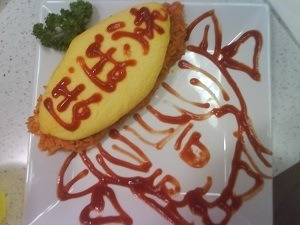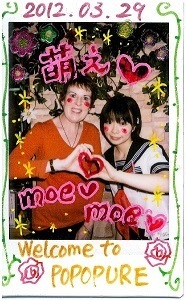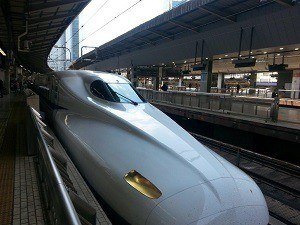Why does Japan have bad travel PR? |
|
|
19 January 2015 Our experiences of travelling extensively in Japan have been overwhelmingly positive. There is the odd occasion when we have struck someone rude, or got ourselves lost, but these are rare. Even when visiting non-tourist areas we have found Japan to be refreshingly safe and its people friendly and welcoming. (For example we once ventured into a small bar in Nagasaki run by an elderly couple who told us we were the first foreigners to visit their bar in 40 years and made us very welcome. Or the bar owner in Tottori who had seen us looking uncertainly in the window, ran outside and asked us to come in.) Everywhere we have been we have come across interesting sights and experiences and a big part of the attraction of visiting Japan is its cultural strangeness when viewing it through Western eyes. Therefore, when we found the following article http://www.japantoday.com/category/travel/view/why-is-japan-such-an-unpopular-tourist-destination we thought it nicely summed up the perceived obstacles we have heard from people who want to visit Japan. These are the very things that travelling with us can mitigate or avoid, resulting in you enjoying a wonderful Japanese holiday. 1 Cost: Yes, Japan can be expensive and we have stayed at a US$1,000 per night room in Tokyo (although we paid half price). However, even in Tokyo there are reasonably priced hotels (especially if you book well in advance) and if you are happy to eat where the locals eat, eating out three times a day can be quite inexpensive. Away from Tokyo and Kyoto, hotels and other costs fall. With JR rail passes transport is cheap and many attractions have minimal entrance fees. And, while Japan is not as cheap to visit as some of its neighbours, it is also not a poor or low-income country. With realistic expectations, a holiday to Japan need not break the bank. 2 Language: The main obstacle here is reading Japanese kanji. Signs in English become less common outside of Tokyo and Osaka, even in large cities like Nagoya and Kyoto. Locals may be shy to try out what little English they remember from school, in fear of making mistakes. But, everywhere you travel there are at least some people that can understand what you are trying to say. In restaurants they may well have an English menu (or you can point at the pictures). At train stations, hotels, tourist information centres and tourist attractions you are likely to find someone that can help. Many train stations have a dedicated counter for tourists. Also, the school system teaches English, so most people will have been exposed to between six and ten years of lessons. Don't count on much spoken language ability as they mainly learn from textbooks, but if you have it written down and speak slowly and clearly, they might understand. Plus, the Japanese have imported a lot of words so a "hamu sando and kohi" will get you a sandwich and coffee. 3 Convenience: When travelling, take yen. For big expenses like hotels, overseas credit cards are fine, but for everyday items cash is a must. And 7-11 convenience stores and post office ATMs take foreign cards if you need to withdraw more cash. (Also, 7-11 and the other "combini" (convenience stores) sell a useful range of supplies and it is worth knowing what you can get in an emergency 24 hours a day, such as chocolate ice cream at midnight). 4 Make the most of Japan: While people can put up reasons not to visit Japan, they also miss out on all the things that make Japan such a great holiday destination. It has amazing scenery, a polite and safe society, great festivals and attractions. Above all it has a pervading spirit of fun that many other countries lack. |
Expensive seafood!
|
Tour recap - November 2014 |
|
|
27 December 2014 We have posted a selection of photos from our November tour on www.facebook.com/JapanCustomTours.co.nz, but as not everyone uses Facebook, we have added some here. (Our Facebook page is public, so you can view it without having to have a Facebook account.) After flying into Narita, we travelled to the bottom of Kyushu to Kagoshima, the end of the Shinkansen line. Kagoshima provided a good base from which to visit the Chiran Peace Museum for Kamekazi pilots; the Ibusuki hot sand baths (and onsen) and the local volcano, Sakurajima.
View from Sakurajima across to Kagoshima Heading north again we spent a day at the sumo tournament in Fukuoka. With the increasing popularity of sumo, we purchased tickets in advance which afforded us good seats and an excellent view. It was very exciting to be able to see the top wrestlers in action. This included seeing the top wrestler Hakuho, who secured his 32nd Emperor's Cup and equalled the record set by the great wrestler Taiho in 1971. We then went on to Nagoya for a few days, to catch up with friends. We visited several places that don't feature in the popular guidebooks e.g. the ScMaglav Train museum which is one of the highest rated attractions (by the Japanese) and is easy to get to from the main train station. We were also fortunate to be able to visit Meiji Mura Museum, a 1,000,000 m2 park with buildings, vehicles and machinery etc from the Meiji era (1868 to 1912). Some 60 buildings have been relocated to this park which is a one hour drive from the central city. Finally, we spent a few days in Kyoto at the peak of the autumn leaf viewing season. We went to Arashiyama and spent ages there drinking in the stunning colours of the maple leaves in this picturesque area. Another highlight was paying a return visit to the sashimi (raw seafood, and sushi) restaurant we visited earlier this year. The chef is a wonderful, friendly host and we look forward to returning to his restaurant when next in Kyoto.
Views from Arashiyama, Kyoto
|
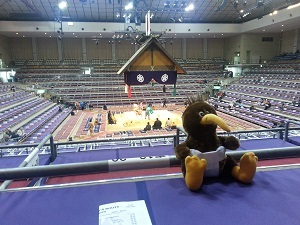
Sumo at Fukuoka, Kyushu 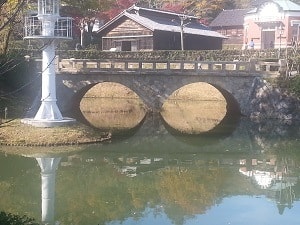
"Spectacles" bridge Meiji Mura Museum near Nagoya
Autumn colour at Meiji Mura Museum near Nagoya
Bamboo at Arashiyama, Kyoto |
Chiran Peace Museum |
|
|
17 November 2014 We are staying in Kagoshima for a few days as there are many things to see and do in this corner of Japan. Today we visited the Chiran Peace Museum which was built in memory of the Tokko (Special Attack) pilots - known internationally as Kamikaze pilots - and to promote peace. The museum was built on the actual site of the airfield where the pilots trained and departed from. There are two main ways of getting to and from Chiran: train then bus (about an hour), or bus only (hour and a half). Taking the bus-only option is easier (Y940 each way - it is useful to have the correct change), as you do not need to find the correct bus stop after you get off the train. The buses run hourly, so if you take the train and then miss the bus, you'll have lots of waiting time in the middle of nowhere...
The bus trip takes you away from the coast into the nearby hills, as the old airfield (some 500 acres) was situated a short distance inland. After travelling through the countryside it is a surprise to arrive at Chiran and see the large number of tour buses in the car park. Most visitors we saw were elderly Japanese and we saw only two other foreigners besides ourselves. Our photos are all taken in the grounds outside as photos are not allowed in the museum. Like the peace museums we have visited at Hiroshima and Ngasaki, this is a sombre place, and the grey day added to that. The 1,036 stone lanterns mark the souls of each young men that died in the kamikaze raids. Inside (Y500 admission and Y100 for rental of an English audio guide) are artefacts and stories of the pilots. There is a photograph of each man, arranged chronologically by their date of death. It is striking how young these "men" were, many facing death before getting out of their teens. Their final words and thoughts as poignant today as they were in 1944 and 1945. While opinions on WWII will differ, we found our visit to the museum very interesting. It provides an enduring memorial to the young kamikaze pilots. |
|
Maid Cafes |
|
|
1 November 2014 Akihabara (Tokyo) saw the first
Maid Cafe established in 2001 and since then they have become an
established niche in the cos-play restaurant scene. Competing for
business, most often you will encounter maids on the street handing out
flyers. Showing interest can quickly lead to being dragged to the
cafe (sometimes across streets and down walkways) before exiting an
elevator into the cafe itself. Maid Cafes are a great place to experience Japanese pop culture and have a tasty rice omelette or a selection of sweet cakes. Each cafe has its own rituals or style and may include opportunities to talk, play games or voice-over an anime on screen. |
|
Happy 50th Birthday Shinkansen |
|
|
1 October 2014 The Shinkansen (bullet train) turned 50 on 1 October 2014. As a technological feat, it was remarkable at the time and remains impressive 50 years later. The high speed train network across Japan is more than just a fast way of getting from A to B, as it has become part of the culture of the country itself. While the original 1964 network suffered from massive cost over-runs, the impact of short travel times has resulted in much less reliance on domestic air travel and allowed the population to enjoy easy access to many areas of the country. More convenient than air travel, faster and more comfortable, travelling by Shinkansen is something that all visitors to Japan should experience. With additions to the network (linking the Kyushu line to Hakata in 2011 and the proposed 2015 opening of the link to Kanazawa), the current 300 million passenger trips per year may yet surpass the peak of 353 million trips seen in 2007. Relevant video covering the 50th anniversary can be seen at the following links: |
|
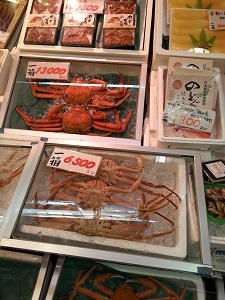
 Do not feed the birds.
Do not feed the birds.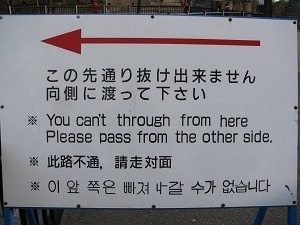 Signs in Japanese, English, Chinese and Korean
Signs in Japanese, English, Chinese and Korean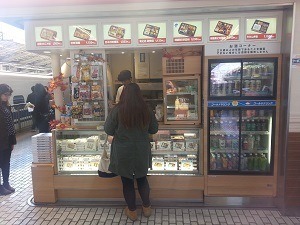 Food and drink very handy
Food and drink very handy
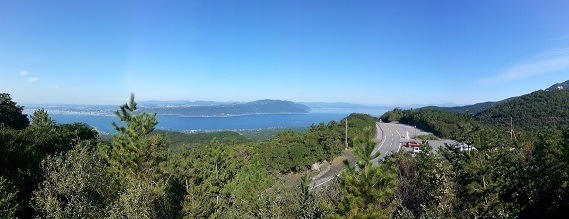
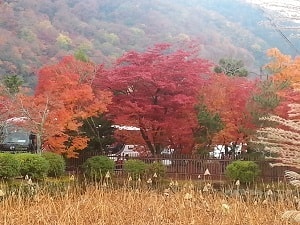
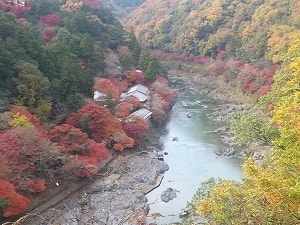
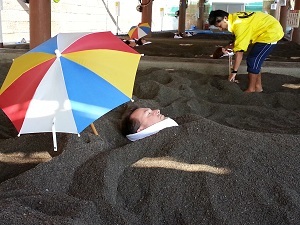
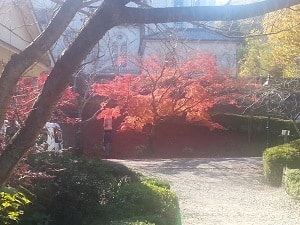
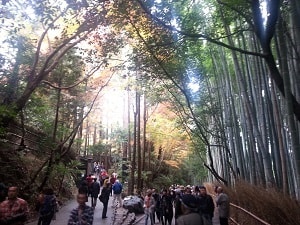
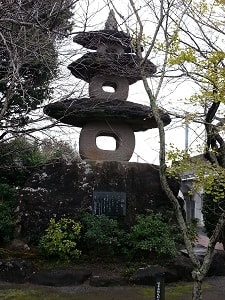
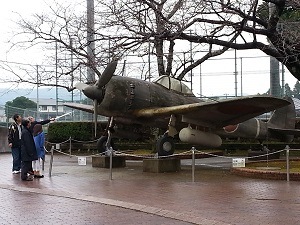
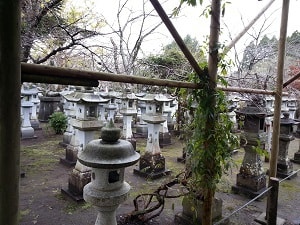 Stone lanterns, one for each pilot
Stone lanterns, one for each pilot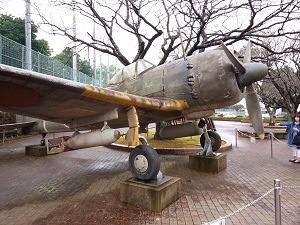
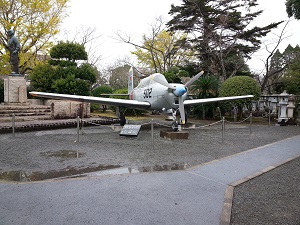 Relics of WWII
Relics of WWII